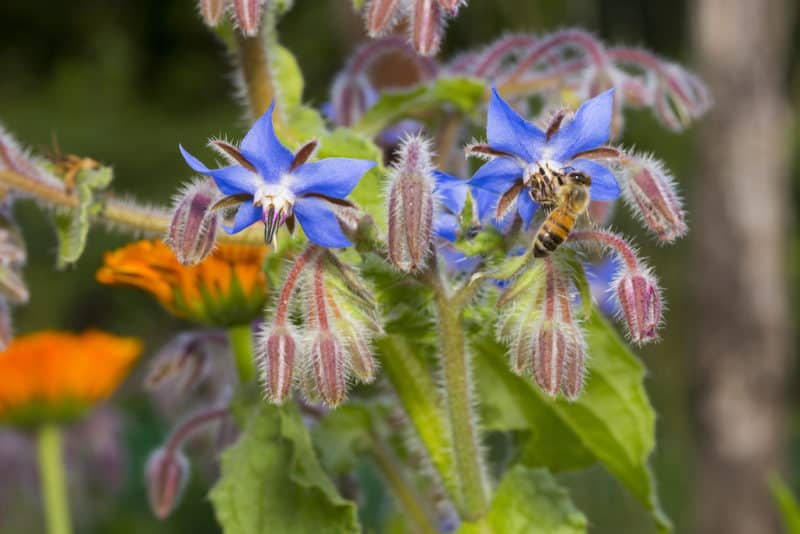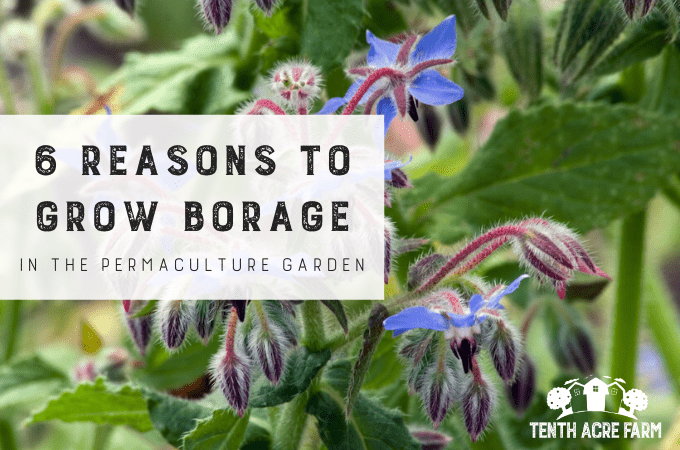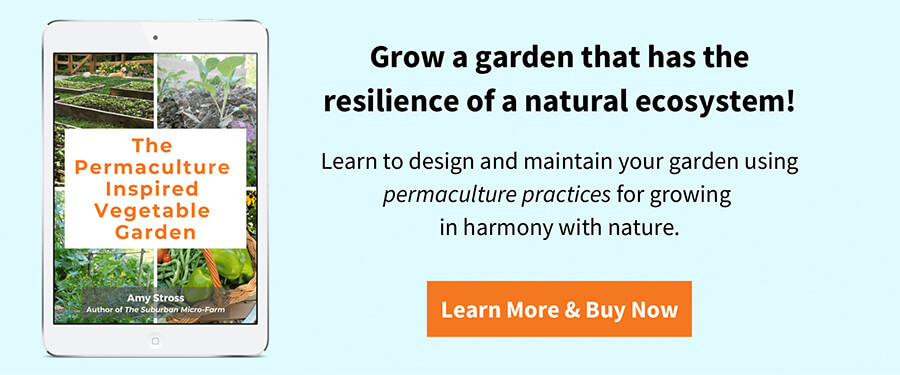6 Reasons to Grow Borage in the Permaculture Garden
Borage is a useful herb with delightful blue-purple flowers. Here are six reasons to grow this cousin to comfrey in the permaculture garden.


This page may contain affiliate links. Please read my disclosure for more info.
Borage and Comfrey: Kissing Cousins
Borage (Borago officinalis) is a favorite herb for the permaculture garden. Did you know that it’s a cousin to comfrey, the superstar permaculture plant? 🤯
It’s true! The two plants are both in the Boraginaceae family. With all of the uses for comfrey in the garden, you can assume that we have big expectations for borage!
While they share many characteristics, however, they aren’t always interchangeable. We’ll look at their similarities and differences throughout this article as we explore all the benefits to growing borage.
Growing Borage
This drought-tolerant herb is an all-season bloomer of blue, star-shaped flowers that turn to purple, then fade to pink as they age. An easy-to-grow herb, sow it directly in the garden, and it will self-sow every year after that on its own.
One of the biggest differences between comfrey and borage is that comfrey is a perennial while borage is an annual. Subsequently, this determines how to use and care for each.
Notes on sowing borage:
- For faster germination, refrigerate the seeds two weeks before sowing in the spring.
- Don’t cover seeds after sowing.
- Sow borage seeds in full sun and well-drained soil.
This plant actually prefers poor soil and will get leggy if the soil is too rich. Its expected height is 24 inches high, with a 12-inch width.
The following are some of the biggest reasons and benefits for growing borage.
1: Eat Your Herbs
Borage flowers and young leaves are a wonderful, edible treat with a mild cucumber flavor.
The blue-purple flowers make a cheerful topping on salads and desserts, as well as an attractive addition to cream cheese spreads, according to Tammi Hartung in Homegrown Herbs: A Complete Guide to Growing, Using, and Enjoying More than 100 Herbs.
Pro Tip: Float the flowers in a glass of chilled lemonade for a refreshing summer treat.
Young green leaves, on the other hand, are a nutritional powerhouse much like spinach. Sauté them lightly in oil for a dish high in vitamins A and C, iron, and niacin.
According to Darrel Frey, author of Bioshelter Market Garden: A Permaculture Farm, “Most of the flavor is in the calyx, which is the star of green sepals that support the blue petals.”
Note: Borage and comfrey diverge on this issue. Although comfrey is a potent medicinal herb for topical application, it isn’t recommended for internal consumption.
Would you like to grow more food with less effort? Check out my mini guide, The Permaculture Inspired Vegetable Garden.
2: Borage Feeds Pollinators and Shelters Beneficial Insects
It’s easy to see why borage is also called ‘bee bread’. Bees, hummingbirds, and other pollinators flock to this plant that is so rich in nectar.
Pro Tip: Grow this triple combo for superb pollination: Borage, bee balm, and comfrey.
The dense plants shade the soil below, keeping it cool. This makes both borage leaves and the soil below a wonderful habitat for beneficial insects like lacewings and parasitoid wasps, which help keep pests in check.
Learn more about preventing pests in the permaculture garden.


3: Chop-and-Drop Mulch to Suppress Weeds
Borage and comfrey both produce epic amounts of plant matter. To make the most of this biomass, chop it back regularly for chop-and-drop mulch. This mulch both suppresses weeds and enriches the soil as it decomposes.
In permaculture, this is an example of using and valuing renewable resources. Creating your own mulch on site reduces the need to buy/import materials.
There are two ways to go about making chop-and-drop mulch, and which you choose depends on your goals.
— 1. Cut borage back just before it flowers if your primary goal is enriching the soil and suppressing weeds.
This is when the plants contain the most amounts of soil-enriching nutrients. Lay the plant matter directly on the soil surface. So if there’s an existing mulch already on the soil, tuck the borage cuttings underneath it.
Some consider borage to be annoyingly dispersive. However, when you cut the plants back early, they don’t set seed.
— 2. Cut borage back after the flowers have finished blooming if your primary goal is pollination.
By allowing the plants to flower, pollinators get the most from them. However, the plants may also set seed, which isn’t necessarily a negative. They’re sowing the next generation of plants for you.
Keep in mind that the vigorously growing plants can become quite wild as they mature, so cutting them back, whether before or after flowering, will help to tidy things up. This may even encourage them to bloom again.
Pro Tip: Wear gloves to handle the mature, hairy leaves.
Personally, I enjoy a combination of the two approaches to make the most of borage. By cutting half of my plants back early, I get nutrient-rich, weed suppressing mulch, and by allowing half of them to flower before cutting, I attract pollinators and sow the next generation of seeds.
I even allow some of the wild plants to remain standing in the garden all season, in case beneficial insects have chosen my garden for shelter and reproduction.
As mulch, nectar, and habitat stars, both comfrey and borage have similar characteristics.
Read about five ways to mulch in the permaculture garden.
Tired of generic permaculture design advice that you can’t apply to your specific goals? If so, check out my Permaculture Design Program and get the tools and support needed to create and implement your own permaculture design.
4: Catch Nutrients to Aid Soil Health
Over the last 40 years, permaculture literature has promoted the use of what’s called ‘nutrient accumulators’ or ‘nutrient catchers’. The roots of nutrient accumulators tap the subsoil for nutrients and concentrate these nutrients in their leaves. The leaves then go on to enrich the topsoil when they decay.
In theory, this reverses nutrient loss and enriches topsoil without having to buy a bunch of fertilizers. As nature’s medics, the theory goes, these nutrient accumulators bring nutrients to where our crops need them, in a form that they can use.
Named as nutrient accumulators, comfrey and borage both have the potential to aid soil. (Yarrow is another of my favorite nutrient accumulators.)
According to Louise Riotte, author of Carrots Love Tomatoes (1975), “Borage is an excellent provider of potassium, calcium, and other natural minerals of benefit to plants.”
Although the data is spotty, I choose to plant a variety of these nutrient accumulators just in case. There’s a lot we don’t know about the complexity of nature, but what we do know is that these plants contribute to an ecologically rich garden.
Pro Tip: Plant nutrient accumulators, just in case they’re cycling nutrients and enriching topsoil!
5: Companion Planting in the Vegetable Garden with Borage
The research on companion plants, much like that for nutrient accumulators, is a bit spotty, and some of it is probably just lore. There are a lot of variables that go into whether certain plants actually support the growth of our favorite crops or whether some crops are just more tolerant of plants growing nearby.
That said, it doesn’t hurt to try a few companion planting combinations for yourself. Gardening, after all, is much more fun when we run our own experiments! In fact, I love to plant flowers throughout my vegetable garden.
Jerry Baker, of The Impatient Gardener, likes to plant borage with tomatoes to deter hornworms and improve growth and flavor.
Borage is also said to be a friend of the squash family, increasing pollination rates of crops like cucumbers, pumpkins, zucchini, and melons. Find some other companions for cucumbers here.
While comfrey (a perennial) tends to be a good companion for perennial crops, borage (an annual) makes a good companion to both annual and perennial crops.


6: Planting Borage with Fruit Crops
Because borage is a self-sowing annual, it’s easy to throw a few seeds around fruit crops to help enrich the ecosystem with biodiversity. Biodiverse plantings tend to be more self-sufficient and resistant to pests and disease.
Based on what we know about borage, it can be a wonderful addition to fruit tree guilds.
A fruit tree guild is a common permaculture strategy for creating a supportive understory that attracts pollinators and beneficial insects while providing weed-suppressing and nutrient rich mulch.
For example, Dave Jacke in Edible Forest Gardens, Vol. 1, describes an attractive plum tree guild fit for the edible landscape, which includes an understory of borage, currants, fennel, kale, and a sweet woodruff ground cover.
Meanwhile, Toby Hemenway in Gaia’s Garden: A Guide to Home-Scale Permaculture, describes an apple tree guild that includes an understory of astragalus, basil, borage, clover, currants, dill, fava bean, garlic, lupine, mint, Siberian pea shrub, and wildflowers.
Read about how I use borage in permaculture fruit tree guilds.
Borage is also popularly used as a border for strawberry beds. (I like to grow chives with my strawberries, too!)
All in all, borage is a wonderfully delightful flower, useful herb, and a powerhouse in the garden. As comfrey’s cousin, we shouldn’t be too surprised of how well it supports our garden goals and improves biodiversity!
Have you grown borage in your garden?
READ NEXT:









